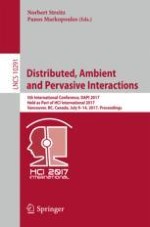This book constitutes the refereed proceedings of the 5th International Conference on Distributed, Ambient and Pervasive Interactions, DAPI 2017, held as part of the 19th International Conference on Human-Computer Interaction, HCII 2017, held in Vancouver, BC, Canada, in July 2017. The total of 1228 papers presented at the 15 colocated HCII 2017 conferences
was carefully reviewed and selected from 4340 submissions. These papers address the latest research and development efforts and highlight the human aspects of design and use of computing systems. The papers accepted for presentation thoroughly cover the entire field of human-computer interaction, addressing major advances in knowledge and effective use of computers in a variety of application areas.
This volume contains papers addressing the following major topics: designing and evaluating distributed, ambient and pervasive interactions; natural interaction; smart cities; art and cultural heritage in smart environments; smart environments for quality of life; smart environments for learning and creativity; and ambient games and humour.
